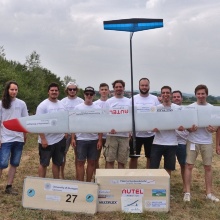The Air Cargo Challenge competition that took place from August 8-11 in Zagreb, offers academic model sport groups the chance to compete against each other. The aim was to use a remote controlled aircraft to transport the heaviest possible cargo load around a set course as quickly as possible. The University of Stuttgart’s student group Akamodell Stuttgart e. V. was able to secure its third win, following previous successes in 2009 and 2013.
The Akamodell team, comprising students and doctoral students studying Aerospace Engineering and Mechanical Engineering and under the patronage of Prof. Andreas Strohmayer from the Institute of Aircraft Design, were able to rise to the challenge with their fiber-reinforced composite aircraft. In addition to the flight task, the competition also included a written report and a presentation. The Akamodell team were awarded not only a trophy, but also a cash prize of 1,000 euros. Teams from universities in Europe, Egypt and China competed at the event and in line with the event’s international character, the Akamodel team included members from Germany, France, Bulgaria, Greece and Sweden. The winning team at the Air Cargo Challenge also has the honor of hosting the next competition, so it is highly likely that the competition in 2019 will be held in Stuttgart again.
Electric drive and adherence to a specified take-off distance were prerequisites for participation
To ensure that all competitors competed under the same conditions, the competition specifications demanded the use of an electric drivetrain comprising an engine, propeller and a three-cell rechargeable lithium battery. The permitted electric power input was approximately 500 W. An additional criterion was that the aircraft must fit into a box measuring 1 m x 0.5 m x 0.4 m when dismantled. The aircraft must be capable of flying with the cargo of steel plates using a take-off distance of 60 m. The aircraft was allowed to climb for 30 seconds before commencing the oval course with 100 m distance between the vertexes. It was required to navigate around these ten times. The points awarded for the flight were determined using a formula where the cargo load was used as the numerator and the time taken to complete the course as the denominator. The best two from a total of six flights were used to determine the final results.
Teams of students construct and build the models themselves
The competition is held every two years and the rules are altered slightly each time, which means that the aircrafts need to be newly designed and constructed each time to ensure the best possible result. Extensive practical knowledge and experience is also necessary, alongside the skills developed at university that include aircraft design, aerodynamics, flight mechanics, electrical engineering, structural mechanics and construction. The members of Akamodell develop these practical skills by participating in numerous projects. At the beginning of the design process, the Akamodell team created a simulation of an entire flight in order to optimize the design by using variations of parameters such as wingspan and wing area. The construction was then refined with a specially designed airfoil profile that demonstrated both a high maximum lift and a low minimum drag. However, the design phase did not seek to build the optimum theoretical model, the team considered the flight characteristics and maneuverability and developed a slightly smaller aircraft with a wingspan of 3.9 m and a wing area of 1.2 m².
The airfoil and rump were constructed using a CNC-milled carbon fiber sandwich. The consistently lightweight construction ensured a light take-off weight (without cargo load) of 3.2 kg.
A victory with 10.2 kg cargo load and 80 km/h
The aircraft was able to transport more than three times the empty weight (10.2 kg). During the crucial flight, the aircraft flew around the oval course ten times in 62 seconds, demonstrating an average speed of over 80 km/h. Although a number of teams managed to outdo the Stuttgart team in terms of maximal load, the reduced drag design provided a huge advantage as the other competitors were unable to match the speed of the Stuttgart aircraft. Because the Akamodell team were already ahead thanks to the points gained from the technical report and the presentation, victory was within reach even early on in the competition. At the end of the challenge, Akamodell Stuttgart and two teams from Akamodell Munich were rewarded with a place on the podium. Fourth place was awarded to the team from the University of Udine in Italy, who also put on an impressive performance.
In 2018 Akamodell Stuttgart will celebrate its 40th anniversary
The Akamodell Stuttgart e. V., established in 1978, is the oldest academic model aircraft sport group in Germany. The goal of this non-profit student association is to promote model aircraft sport and to gain practical experience to complement theoretical university teaching. The association’s headquarters is a workshop on the Vaihingen campus, made available by the University of Stuttgart. Extensive individual and group projects are regularly awarded top places in both national and international competitions.
Akamodell Stuttgart would like to thank its supporters
Without support from numerous funding associations and sponsors, the Akamodell team would not have been able to participate in the Air Cargo Challenge. Special thanks go to the association Friends of the University of Stuttgart e. V., the association Friends of Aerospace Engineering and to the University of Stuttgart for providing the premises.
Contact
Jonas Gude, Air Cargo Challenge Team Leader, Institute of Aerodynamics and Gas Dynamics (IAG), 0711 685 62751, email
Matthias Schmid, chairperson at Akamodell Stuttgart e.V., 0711 685 62098, email


